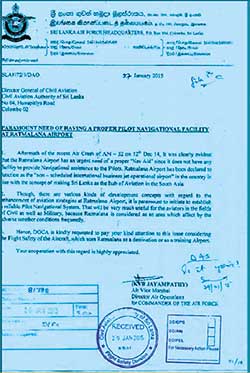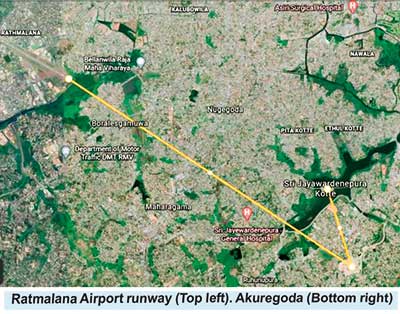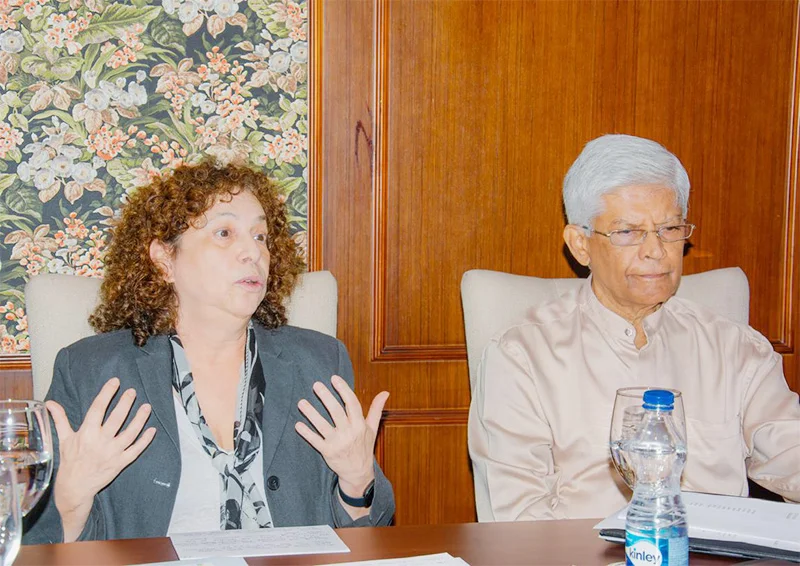Features
Ratmalana airport’s operations and unplanned development

Wellington Airport, New Zealand, Control Tower, in a shopping Mall
By Capt G A Fernando MBA
gafplane@sltnet.lk
President, Aircraft Owners and Operators Association
RCyAF, Air Ceylon, Air Lanka, SIA, SriLankan Airlines
In 1934 the State Council of Ceylon decided that an airport with easy access to Colombo was a necessity and declared that Ratmalana was the best site available. Accordingly an airfield was built and the first landing took place on 27 November 1935. This was Ceylon’s first Airfield. With the advent of WW II, the airport expanded and a runway was also built. The Royal Air Force (RAF) and the Fleet Air Arm used it.
To assist aircraft landing in bad weather and resulting bad visibility, a transmitter was built at Thalangama to generate a Radio Signal Beam directed along the extended centre line of the runway at Ratmalana. If the aircraft was tracking the correct path, the pilots would hear a continuous tone on their head sets. However if they were left of the desired track, the pilots would hear a letter ‘A’ in Morse code (dit dah) or if right, a letter ‘N’ which was a (dah dit) in Morse. The objective was to hear a continuous signal in the ears, which guided them towards Ratmalana. The decent to lower altitude was at the pilot’s discretion.
 As time went by, there was a low frequency, Non Directional Radio Beacon (NDB) placed in the vicinity of the airport (Attidiya) and used with an Automatic Direction Finder (ADF) on board the aircraft. A needle over a compass dial pointed to Attidiya and gave directional guidance to international air traffic. Although it could accommodate an unlimited number of aircraft, when they needed it most like during thunderstorms activity, there was static interference and the needles pointed towards the thunderstorms instead of Attidiya. So a Very High Frequency Omni Directional Radio Range known as a ‘VOR’ for short was installed for more accuracy.
As time went by, there was a low frequency, Non Directional Radio Beacon (NDB) placed in the vicinity of the airport (Attidiya) and used with an Automatic Direction Finder (ADF) on board the aircraft. A needle over a compass dial pointed to Attidiya and gave directional guidance to international air traffic. Although it could accommodate an unlimited number of aircraft, when they needed it most like during thunderstorms activity, there was static interference and the needles pointed towards the thunderstorms instead of Attidiya. So a Very High Frequency Omni Directional Radio Range known as a ‘VOR’ for short was installed for more accuracy.
Then in 1968, Ratmalana International Airport lost its ‘International’ status when the Bandaranaike International Airport opened and all international operations moved to Katunayake. The equipment at the airport was allowed to deteriorate. The Radio Navigational let down aids ran down. There was no proper Control Tower. Even the runway lights were not working and night flights had to depend on Kerosene Lamps. One redeeming grace, in the night, in those days, was that the Sapugaskanda Oil Refinery was in full production and the giant flare of the burning gasses was the guiding light to the Ratmalana Airport. The Pilots spotted the flare from far away and flew over the Refinery and then turned on the runway heading and could see the runway edge kerosene flares, flickering dimly in a dark patch that was the Ratmalana airport! The civil training aircraft of the Government Flying School of those days had neither radios nor any radio aids to navigation.
Post 1977, after the ‘Dharmista’ Government created another problem for Ratmalana operations. The authorities decided to build a new Capital in Sri Jayewardenepura, Kotte, and also move the New Parliament to that neck of the woods. Unfortunately, the Parliament was just 3.6 Nautical Miles from the end of the Ratmalana runway ‘as the crow flies’ and less than 1NM from the Thalangama Transmitters. In most countries overflying the Parliament is prohibited. Therefore the Authorities blindly decreed the same in Sri Lanka. Thus restricting the freedom of aircraft movements to the Ratmalana Runway and preventing safer, conventional landing approaches. It must be noted that Air Ceylon and other domestic flights were still using Ratmalana. Many professionals were quick to observe that it was akin to someone building a house near a railway line and then complaining that it was too noisy and requiring the railway to divert!
Everyone had learnt to live with the non-availability of precision Navigational aids at Ratmalana. Thalangama Transmitters lost its significance. The Urban Development Authority (UDA) eventually, took vacant procession and the SL Army (Gemunu watch) established a camp there. During December, with clear nights and cooler mornings, (Temperature inversions) combined with the North Easterly winds blowing smoke from the Sapugaskanda Refinery, the visibility on the final approach tends to get very bad at the Ratmalana airport.
In fact, on the morning of 14 December 2014, a SLAF Antonov AN 32, ferry flight from Katunayake, attempted to approach for landing at Ratmalana and crashed killing the crew. This prompted the then Air Force Commander to write to the then Director General of Civil Aviation (DGCA) to reinstall Navigational Facilities (See Letter below). Now almost five years have gone by and at last the Airport and Aviation Sri Lanka (AASL) is slowly waking up to the fact that not only the seen but also the unseen facilities at Ratmalana should be brought up to standard in the name of air safety. Wide publicity is given to the fact that the Government’s intention is to make Ratmalana an International Business aircraft hub and regain its lost glory.
 While this concept is being actively pursued by the Airport and Aviation Sri Lanka Ltd (AASL) and the Civil Aviation Authority Sri Lanka (CAASL), another security sensitive building has been erected in the vacant land at Thalangama, barely 1 NM from the Parliament and 4.4 NM from the runway end. That being the Akuregoda Military Headquarters. This has created an effective barrier for operation of legitimate air traffic. As a direct result more restrictions are bound to be imposed on inbound air traffic. Furthermore, it does seem like that there was no ‘master plan’ and the left hand didn’t know what the right hand was doing.
While this concept is being actively pursued by the Airport and Aviation Sri Lanka Ltd (AASL) and the Civil Aviation Authority Sri Lanka (CAASL), another security sensitive building has been erected in the vacant land at Thalangama, barely 1 NM from the Parliament and 4.4 NM from the runway end. That being the Akuregoda Military Headquarters. This has created an effective barrier for operation of legitimate air traffic. As a direct result more restrictions are bound to be imposed on inbound air traffic. Furthermore, it does seem like that there was no ‘master plan’ and the left hand didn’t know what the right hand was doing.
Air safety dictates that jet planes should have at least an eight mile straight in (no turns) final approach. Now it is not possible to do that with the unplanned sensitive buildings on the final approach to Ratmalana. Ideally, like in other countries, all three parties, the Local Municipality Town Planer, the Civil Aviation Authority/ Airport and Aviation Ltd (CAASL/ AASL), and the Building developer, must make these long term decisions. In Australia for instance the CAA’ Airports Authority has control of manmade obstacles for a radius of 25 miles. Unplanned buildings, called ‘man made relief’ as against ‘Geographic Relief’ (terrain) has spoilt the feasibility of the intended City Airport. Another case in point is the Kotalawala Defence University (K DU). Which is the tallest building in the vicinity of the airport that should never have been allowed to be built that high. This seems to be the malady this whole country is suffering from. The people in the know are afraid to speak. Subsequently, no one is held accountable for these poor, uncoordinated decisions. The true professionals are not consulted. As a result vision is ‘tunnelled’. The Sinhala saying “Leda malath, bada suddai” seems to be very appropriate. (Although the patient died, the bowels were clean!)
It is believed that accommodating Business Jets inbound to Ratmalana airport will be a money spinner and a step in the correct direction. There is no point in crying over spilt milk one would say. What is done is done. I write to offer a practical solution.to mitigate the adverse effects of unplanned buildings. While the Military Base is working 24/7 (around the clock) and overflying prohibition may be justified, the Parliament ‘works’ only on certain days and for limited hours. The Authorities should provisionally allow air traffic, inbound to Ratmalana to overfly the Parliament on days and times that there are no sittings. A Notice to Airmen (NOTAM) could be issued as and when necessary. In other words let’s share the airspace for the benefit of all, without attempting to kill the goose that may lay the golden egg. Then longer and therefore safer approaches could be designed to facilitate these small but fast Business Jets which will be operating in and out of the Ratmalana Airport.
The Ratmalana Airport lacks a proper Control Tower with a 360 degree visibility of the area. A new Control Tower could be sited in the highest point in the vicinity. Perhaps at KDU to mitigate the hopeless situation. The Wellington, New Zealand Control Tower is on top of a Shopping Mall!
To put this in the correct perspective, according to the FAA (Federal Aviation Administration) USA, research shows that light training aircraft and other small aircraft of the size and mass of business jets cannot create catastrophic destruction to strong buildings like our Parliament or the Military Base, like what happened on 9/11 with large passenger jets. Some even say that the Pentagon was damaged by a missile and not a passenger aircraft. But that’s another story. 
Features
SL urged to use GSP+ to the fullest to promote export development

 Sri Lanka needs to take full stock of its current economic situation and use to the maximum the potential in its GSP+ facility for export sector growth. In the process, it should ensure that it cooperates fully with the European Union. The urgency of undertaking these responsibilities is underscored by the issues growing out of the recent US decision to sweepingly hike tariffs on its imports, though differentially.
Sri Lanka needs to take full stock of its current economic situation and use to the maximum the potential in its GSP+ facility for export sector growth. In the process, it should ensure that it cooperates fully with the European Union. The urgency of undertaking these responsibilities is underscored by the issues growing out of the recent US decision to sweepingly hike tariffs on its imports, though differentially.
These were principal ‘takes’ for participants in the Pathfinder Foundation’s Ambassadors’ Roundtable forum held on April 8th at the Colombo Club of the Taj Samudra. The main presenter at the event was Ms. Carmen Moreno Raymundo, Ambassador of the European Union to Sri Lanka and the Maldives. The forum was chaired by Ambassador Bernard Goonetilleke, Chairman, Pathfinder Foundation. The event brought together a cross-section of the local public, including the media.
Ms. Moreno drew attention to the fact Sri Lanka is at present severely under utilizing its GSP+ facility, which is the main means for Sri Lanka to enter the very vast EU market of 450 million people. In fact the EU has been Sri Lanka’s biggest trading partner. In 2023, for instance, total trade between the partners stood at Euros 3.84 billion. There is no greater market but the EU region for Sri Lanka.
‘However, only Sri Lanka’s apparel sector has seen considerable growth over the years. It is the only export sector in Sri Lanka which could be said to be fully developed. However, wider ranging export growth is possible provided Sri Lanka exploits to the fullest the opportunities presented by GSP+.’
Moreno added, among other things: ‘Sri Lanka is one among only eight countries that have been granted the EU’s GSP+ facility. The wide-ranging export possibilities opened by the facility are waiting to be utilized. In the process, the country needs to participate in world trade in a dynamic way. It cannot opt for a closed economy. As long as economic vibrancy remains unachieved, Sri Lanka cannot enter into world trading arrangements from a strong position. Among other things, Sri Lanka must access the tools that will enable it to spot and make full use of export opportunities.
‘Sri Lanka must facilitate the private sector in a major way and make it possible for foreign investors to enter the local economy with no hassle and compete for local business opportunities unfettered. At present, Lanka lacks the relevant legal framework to make all this happen satisfactorily.
‘Sri Lanka cannot opt for what could be seen as opaque arrangements with bilateral economic partners. Transparency must be made to prevail in its dealings with investors and other relevant quarters. It’s the public good that must be ensured. The EU would like to see the local economy further opening up for foreign investment.
‘However, it is important that Sri Lanka cooperates with the EU in the latter’s efforts to bring about beneficial outcomes for Sri Lankans. Cooperation could be ensured by Sri Lanka fully abiding by the EU conditions that are attendant on the granting of GSP+. There are, for example, a number of commitments and international conventions that Sri Lanka signed up to and had promised to implement on its receipt of GSP+ which have hitherto not been complied with. Some of these relate to human rights and labour regulations.
‘Successive governments have pledged to implement these conventions but thus far nothing has happened by way of compliance. GSP+ must be seen as an opportunity and not a threat and by complying with EU conditions the best fruits could be reaped from GSP+. It is relevant to remember that GSP+ was granted to Sri Lanka in 2005. It was suspended five years later and restored in 2017.
‘The importance of compliance with EU conditions is greatly enhanced at present in view of the fact that Sri Lanka is currently being monitored by the EU with regard to compliance ahead of extending GSP+ next year. A report on Sri Lanka is due next year wherein the country’s performance with regard to cooperating with the EU would be assessed. The continuation of the facility depends on the degree of cooperation.
‘A few statistics would bear out the importance of Sri Lanka’s partnership with the EU. For example, under the facility Sri Lanka benefits from duty free access in over 66% of EU tariff lines. The highest number of tourist arrivals in Sri Lanka in 2023 was from the EU’s 27 member states. Likewise, the EU’s 27 member states rank second in the origin of inflows of foreign exchange to Sri Lanka; with Italy, France and Germany figuring as the main countries of origin. Eighty five percent of Sri Lanka’s exports to the EU market benefits from GSP+. Thus, the stakes for the country are high.’
Meanwhile, President, In-house Counsel & Legal Advisor, The European Chamber of Commerce of Sri Lanka, John Wilson said: ‘GSP+ should be seen as not only an opportunity but also as a necessity by Sri Lanka in the current international economic climate. ‘Implementation of local laws is what is needed. Considering the pressures growing out of the US imposed new tariff regime, a good dialogue with the EU is needed.
‘Sri Lanka’s level of business readiness must be upped. Among the imperatives are: An electronic procurement process, Customs reforms, a ‘National Single Window’, stepped-up access to land by investors, for example, a clear policy framework on PPPs and reform of the work permits system.’
It ought to be plain to see from the foregoing that Sri Lanka cannot afford to lose the GSP+ facility if it is stepped-up economic growth that is aimed at. It would be in Sri Lanka’s best interests to remain linked with the EU, considering the aggravated material hardships that could come in the wake of the imposition of the US’ new tariff regime. Sri Lanka would need to remain in a dialogue process with the EU, voice its reservations on matters growing out of GSP+, if any, iron out differences and ensure that its national interest is secured.
Features
SENSITIVE AND PASSIONATE…

Chit-Chat
Chiara Tissera
Mrs. Queen of the World Sri Lanka 2024, Chiara Tissera, leaves for the finals, in the USA, next month
I had a very interesting chat with her and this is how it all went:
1. How would you describe yourself?
I am a sensitive and passionate individual who deeply cares about the things that matter most to me. I approach life with a heart full of enthusiasm and a desire to make meaningful connections.
2. If you could change one thing about yourself, what would it be?
Actually, I wouldn’t change a thing about myself because the person I am today, both inside and out, is the result of everything I’ve experienced. Every part of me has shaped who I am, so I embrace both my strengths and imperfections as they make me uniquely me.
3. If you could change one thing about your family, what would it be?
If there’s one thing I could change about my family, it would be having my father back with us. Losing him six years ago left a void that can never be filled, but his memory continues to guide and inspire us every day.
4. School?
I went to St. Jude’s College, Kurana, and I’m really proud to say that the lessons I gained during my time there have shaped who I am today. My school and teachers instilled in me values of hard work, perseverance and the importance of community, and I carry those lessons with me every day. I was a senior prefect and was selected the Deputy Head Prefect of our college during my tenure.
5. Happiest moment?
The happiest moment of my life so far has been winning the Mrs. Sri Lanka 2024 for Queen of the World. It was a dream come true and a truly unforgettable experience, one that fills me with pride and gratitude every time I reflect on it.
6. What is your idea of perfect happiness?
Happiness is a deeply personal and multifaceted feeling that often comes from a sense of contentment, fulfillment and well-being. For me, perfect happiness is in moments of joy, peace and accomplishments … and also being surrounded by my loved ones.
7. Are you religious?
Yes, I’m a very religious person. And I’m a firm believer in God. My faith guides me through life, providing strength, dedication and a sense of peace in every situation. I live by the quote, ‘Do your best, and God will do the rest.’
8. Are you superstitious?
I’m not superstitious. I believe in making my own decisions and relying on logic and faith rather than following superstitions.
9. Your ideal guy?
My ideal guy is my husband. He is compassionate, understanding and is always there to support me, no matter what. He’s my rock and my best friend – truly everything I could ever want in a partner.
10. Which living person do you most admire?
The living person I admire the most is definitely my mummy. Her strength, love and unwavering support has shaped me into who I am today. She is my role model and she inspires me every day with her wisdom and kindness.
11. Your most treasured possession?
My most treasured possession is my family. They are the heart of my life, providing me with love, support and strength. Their presence is my greatest blessing.
12. If you were marooned on a desert island, who would you like as your companion?
I would like to have my spouse as my companion. Together, we could make the best of the situation, supporting each other, sharing moments of laughter and finding creative ways to survive and thrive.
13. Your most embarrassing moment?
There’s quite a few, for sure, but nothing is really coming to mind right now.
14. Done anything daring?
Yes, stepping out of my comfort zone and taking part in a pageant. I had no experience and was nervous about putting myself out there, but I decided to challenge myself and go for it. It pushed me to grow in so many ways—learning to embrace confidence, handle pressure, and appreciate my own uniqueness. The experience not only boosted my self-esteem but also taught me the value of taking risks and embracing new opportunities, even when they feel intimidating.”
15. Your ideal vacation?
It would be to Paris. The city has such a magical vibe and, of course, exploring the magical Eiffel Tower is in my bucket list. Especially the city being a mix of history culture and modern life in a way that feels timeless, I find it to be the ideal vacation spot for me.
16. What kind of music are you into?
I love romantic songs. I’m drawn to its emotional depth and the way they express love, longing a connection. Whether it’s a slow ballad, a classic love song or a more modern romantic tune these songs speak to my heart.
17. Favourite radio station?
I don’t have a specific radio station that I like, but I tend to enjoy a variety of stations, depending on my mood. Sometimes I’ll tune into one for a mix of popular hits, other times I might go for something more relaxing, or a station with a certain vibe. So I just like to keep it flexible and switch it up.
18. Favourite TV station?
I hardly find the time to sit down and watch TV. But, whenever I do find a little spare time, I tend to do some spontaneous binge – watching, catching whatever interesting show is on at that moment.
19 What would you like to be born as in your next life?
Mmmm, I’ve actually not thought about it, but I’d love to be born as someone who gets to explore the world freely – perhaps a bird soaring across continents.
20. Any major plans for the future?
Let’s say preparing and participating in the international pageant happening in the USA this May. It’s an exciting opportunity to represent myself and my country on a global stage. Alongside this, I am dedicated to continuing my social service work as a title holder, striving to make a meaningful difference in the lives of others through my platform.
Features
Fresher looking skin …

 The formation of wrinkles and fine lines is part of our ageing process. However, if these wrinkles negatively impact appearance, making one look older than they actually are, then trying out some homemade remedies, I’ve listed for you, this week, may help in giving your skin a fresher look.
The formation of wrinkles and fine lines is part of our ageing process. However, if these wrinkles negatively impact appearance, making one look older than they actually are, then trying out some homemade remedies, I’ve listed for you, this week, may help in giving your skin a fresher look.
* Banana:
Bananas are considered to be our skin’s best friend. They contain natural oils and vitamins that work very perfectly to boost our skin health. Skincare experts recommend applying the banana paste to the skin.
Take a ripe banana and mash a quarter of it until it becomes a smooth paste. Apply a thin layer of the banana paste on your skin and allow it to sit for 15 to 20 minutes before washing it off with warm water.
* Olive Oil:
Olive oil works as a great skin protector and many types of research suggest that even consuming olive oil may protect the skin from developing more wrinkles. Olive oil contains compounds that can increase the skin’s collagen levels. Yes, olive oil can be used as a dressing on your salads, or other food, if you want to consume it, otherwise, you can apply a thin layer of olive oil on your face, neck and hands and let it stay overnight.
* Ginger:
Ginger serves to be a brilliant anti-wrinkle remedy because of the high content of antioxidants in it. Ginger helps in breaking down elastin, which is one of the main reasons for wrinkles. You can have ginger tea or grate ginger and have it with honey, on a regular basis.
* Aloe Vera:
The malic acid present in Aloe Vera helps in improving your skin’s elasticity, which helps in reducing your wrinkles. Apply the gel once you extract it from the plant, and leave it on for 15-20 minutes. You can wash it off with warm water.
* Lemons:
Lemons contain citric acid, which is a strong exfoliant that can help you get rid of your dead skin cells and wrinkles. Also, as an astringent and a cleansing agent, it helps to fade your wrinkles and fine lines. You can gently rub a lemon slice in your wrinkled skin and leave it on for 10-15 minutes. Rinse afterwards and repeat this process two to three times a day.
* Coconut Oil:
Coconut oil contains essential fatty acid that moisturises the skin and helps to retain its elasticity. You can directly apply the coconut oil, and leave it overnight, after gently massaging it, for the best results.
-

 Business4 days ago
Business4 days agoColombo Coffee wins coveted management awards
-

 Business6 days ago
Business6 days agoDaraz Sri Lanka ushers in the New Year with 4.4 Avurudu Wasi Pro Max – Sri Lanka’s biggest online Avurudu sale
-

 Features5 days ago
Features5 days agoStarlink in the Global South
-

 Business7 days ago
Business7 days agoStrengthening SDG integration into provincial planning and development process
-

 Business6 days ago
Business6 days agoNew SL Sovereign Bonds win foreign investor confidence
-

 Features2 days ago
Features2 days agoSri Lanka’s Foreign Policy amid Geopolitical Transformations: 1990-2024 – Part III
-

 Features5 days ago
Features5 days agoModi’s Sri Lanka Sojourn
-

 Midweek Review2 days ago
Midweek Review2 days agoInequality is killing the Middle Class












